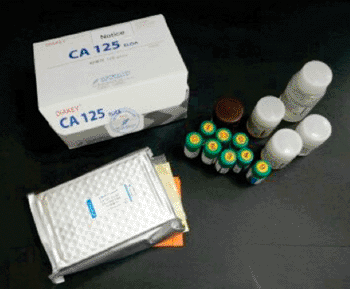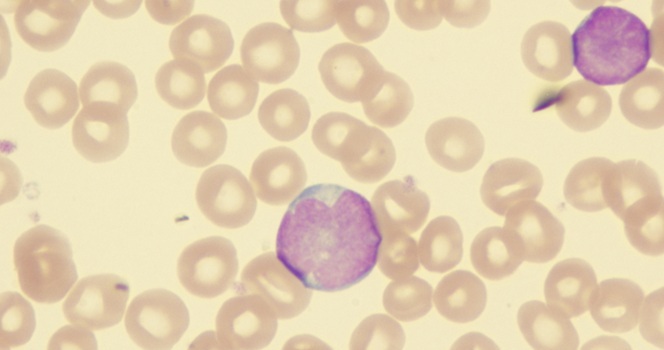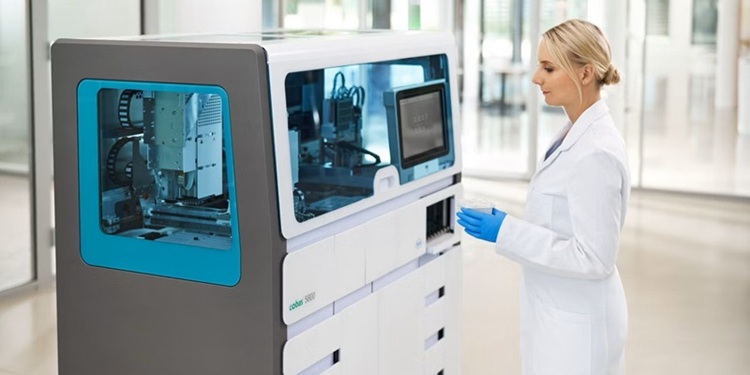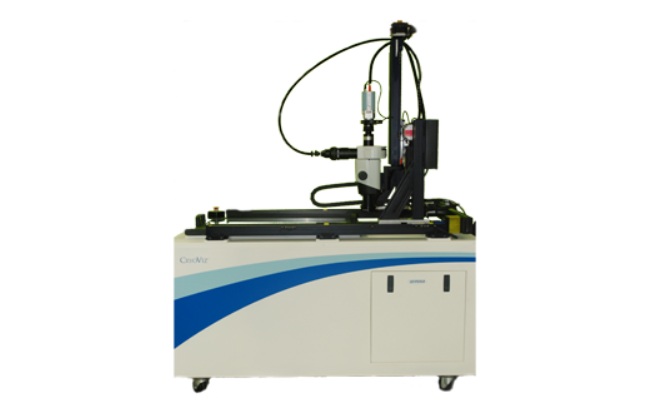Screening Test Evaluated for Early Detection of Ovarian Cancer
|
By LabMedica International staff writers Posted on 23 Sep 2013 |

Image: Cancer antigen 125 (CA-125) enzyme-linked immunosorbent assay kit (Photo courtesy of Alibaba Group).
A protein that has long been recognized for predicting ovarian cancer recurrence now shows promise as a screening tool for the initial phases of the disease.
The simple blood test could offer a much-needed screening tool to detect ovarian cancer in its early stages, even in the most aggressive forms, in postmenopausal women at average risk for the disease.
Scientists at the MD Anderson Cancer Center (Houston, TX, USA) collaborating with other institutions, enrolled 4,051 women from seven sites across the USA, for a prospective, single-arm, 11-year study. All were healthy, postmenopausal women, ages 50 to 74 years, with no strong family history of breast or ovarian cancer. The study’s primary endpoint was specificity, or few false positives. In addition, the study looked at the positive predictive value, or the number of operations required to detect a case of ovarian cancer.
Each woman received a baseline cancer antigen 125 (CA-125) blood test. The Risk of Ovarian Cancer Algorithm (ROCA) was used as a mathematical model based on the patient’s age and CA-125 score. Women were stratified to one of three risks groups, with the respective follow-up: “low,” came back in a year for a follow-up blood test; “intermediate,” further monitoring with repeat CA-125 blood test in three months; and “high,” referred to receive transvaginal sonography (TVS) and to see a gynecologic oncologist.
The average annual rate of referral to a CA125 test in three months was 5.8%, and the average annual referral rate to TVS and review by a gynecologic oncologist was 0.9%. Ten women underwent surgery on the basis of TVS. Cumulatively, 117 women (2.9%) were determined to be high risk, providing a positive predictive value of 40% for detecting invasive ovarian cancer and the specificity was 99.9%.
Robert C. Bast, MD, the senior author of the study, said, “CA-125 is shed by only 80% of ovarian cancers. At present, we are planning a second trial that will evaluate a panel with four blood tests including CA-125 to detect the cancers we may otherwise miss with CA-125 alone. The current strategy is not perfect, but it appears to be a promising first step.” Prof. Bast, who co-invented the CA-125 assay, has worked closely with Fujirebio Diagnostics, Inc. (Malvern, PA, USA) to develop a clinical laboratory test. The study was published on August 26, 2013, in the journal Cancer.
Related Links:
MD Anderson Cancer Center
Fujirebio Diagnostics
The simple blood test could offer a much-needed screening tool to detect ovarian cancer in its early stages, even in the most aggressive forms, in postmenopausal women at average risk for the disease.
Scientists at the MD Anderson Cancer Center (Houston, TX, USA) collaborating with other institutions, enrolled 4,051 women from seven sites across the USA, for a prospective, single-arm, 11-year study. All were healthy, postmenopausal women, ages 50 to 74 years, with no strong family history of breast or ovarian cancer. The study’s primary endpoint was specificity, or few false positives. In addition, the study looked at the positive predictive value, or the number of operations required to detect a case of ovarian cancer.
Each woman received a baseline cancer antigen 125 (CA-125) blood test. The Risk of Ovarian Cancer Algorithm (ROCA) was used as a mathematical model based on the patient’s age and CA-125 score. Women were stratified to one of three risks groups, with the respective follow-up: “low,” came back in a year for a follow-up blood test; “intermediate,” further monitoring with repeat CA-125 blood test in three months; and “high,” referred to receive transvaginal sonography (TVS) and to see a gynecologic oncologist.
The average annual rate of referral to a CA125 test in three months was 5.8%, and the average annual referral rate to TVS and review by a gynecologic oncologist was 0.9%. Ten women underwent surgery on the basis of TVS. Cumulatively, 117 women (2.9%) were determined to be high risk, providing a positive predictive value of 40% for detecting invasive ovarian cancer and the specificity was 99.9%.
Robert C. Bast, MD, the senior author of the study, said, “CA-125 is shed by only 80% of ovarian cancers. At present, we are planning a second trial that will evaluate a panel with four blood tests including CA-125 to detect the cancers we may otherwise miss with CA-125 alone. The current strategy is not perfect, but it appears to be a promising first step.” Prof. Bast, who co-invented the CA-125 assay, has worked closely with Fujirebio Diagnostics, Inc. (Malvern, PA, USA) to develop a clinical laboratory test. The study was published on August 26, 2013, in the journal Cancer.
Related Links:
MD Anderson Cancer Center
Fujirebio Diagnostics
Latest Immunology News
- New Test Distinguishes Vaccine-Induced False Positives from Active HIV Infection
- Gene Signature Test Predicts Response to Key Breast Cancer Treatment
- Chip Captures Cancer Cells from Blood to Help Select Right Breast Cancer Treatment
- Blood-Based Liquid Biopsy Model Analyzes Immunotherapy Effectiveness
- Signature Genes Predict T-Cell Expansion in Cancer Immunotherapy
- Molecular Microscope Diagnostic System Assesses Lung Transplant Rejection
- Blood Test Tracks Treatment Resistance in High-Grade Serous Ovarian Cancer
- Luminescent Probe Measures Immune Cell Activity in Real Time
- Blood-Based Immune Cell Signatures Could Guide Treatment Decisions for Critically Ill Patients
- Novel Tool Predicts Most Effective Multiple Sclerosis Medication for Patients
- Companion Diagnostic Test for CRC Patients Identifies Eligible Treatment Population
- Novel Tool Uses Deep Learning for Precision Cancer Therapy
- Companion Diagnostic Test Identifies HER2-Ultralow Breast Cancer and Biliary Tract Cancer Patients
- Novel Multiplex Assay Supports Diagnosis of Autoimmune Vasculitis
- Blood Test Predicts Immunotherapy Efficacy in Triple-Negative Breast Cancer
- Simple Genetic Testing Could Predict Treatment Success in Multiple Sclerosis Patients
Channels
Clinical Chemistry
view channel
Chemical Imaging Probe Could Track and Treat Prostate Cancer
Prostate cancer remains a leading cause of illness and death among men, with many patients eventually developing resistance to standard hormone-blocking therapies. These drugs often lose effectiveness... Read more
Mismatch Between Two Common Kidney Function Tests Indicates Serious Health Problems
Creatinine has long been the standard for measuring kidney filtration, while cystatin C — a protein produced by all human cells — has been recommended as a complementary marker because it is influenced... Read moreMolecular Diagnostics
view channel
Blood Test to Enable Earlier and Simpler Detection of Liver Fibrosis
Persistent liver damage caused by alcohol misuse or viral infections can trigger liver fibrosis, a condition in which healthy tissue is gradually replaced by collagen fibers. Even after successful treatment... Read more
Genetic Marker to Help Children with T-Cell Leukemia Avoid Unnecessary Chemotherapy
About 400 children in the UK are diagnosed with acute lymphoblastic leukemia (ALL) each year, with roughly 15% presenting with a more aggressive T-ALL subtype. While the standard approach is a four-week... Read more
Four-Gene Blood Test Rules Out Bacterial Lung Infection
Lower respiratory tract infections (LRTIs) are among the most common reasons for antibiotic prescriptions, yet distinguishing bacterial infections from viral ones remains notoriously difficult.... Read more
New PCR Test Improves Diagnostic Accuracy of Bacterial Vaginosis and Candida Vaginitis
Bacterial vaginosis (BV) impacts approximately 25% of women of reproductive age, while up to 75% of women experience candida vaginitis (CV) at least once in their lifetime. Vaginal symptoms are one of... Read moreHematology
view channel
Platelet Activity Blood Test in Middle Age Could Identify Early Alzheimer’s Risk
Early detection of Alzheimer’s disease remains one of the biggest unmet needs in neurology, particularly because the biological changes underlying the disorder begin decades before memory symptoms appear.... Read more
Microvesicles Measurement Could Detect Vascular Injury in Sickle Cell Disease Patients
Assessing disease severity in sickle cell disease (SCD) remains challenging, especially when trying to predict hemolysis, vascular injury, and risk of complications such as vaso-occlusive crises.... Read more
ADLM’s New Coagulation Testing Guidance to Improve Care for Patients on Blood Thinners
Direct oral anticoagulants (DOACs) are one of the most common types of blood thinners. Patients take them to prevent a host of complications that could arise from blood clotting, including stroke, deep... Read moreMicrobiology
view channel
Rapid Diagnostic Test Matches Gold Standard for Sepsis Detection
Sepsis kills 11 million people worldwide every year and generates massive healthcare costs. In the USA and Europe alone, sepsis accounts for USD 100 billion in annual hospitalization expenses.... Read moreRapid POC Tuberculosis Test Provides Results Within 15 Minutes
Tuberculosis remains one of the world’s deadliest infectious diseases, and reducing new cases depends on identifying individuals with latent infection before it progresses. Current diagnostic tools often... Read more
Rapid Assay Identifies Bloodstream Infection Pathogens Directly from Patient Samples
Bloodstream infections in sepsis progress quickly and demand rapid, precise diagnosis. Current blood-culture methods often take one to five days to identify the pathogen, leaving clinicians to treat blindly... Read morePathology
view channelAI Tool Outperforms Doctors in Spotting Blood Cell Abnormalities
Diagnosing blood disorders depends on recognizing subtle abnormalities in cell size, shape, and structure, yet this process is slow, subjective, and requires years of expert training. Even specialists... Read more
AI Tool Rapidly Analyzes Complex Cancer Images for Personalized Treatment
Complex digital biopsy images that typically take an expert pathologist up to 20 minutes to assess can now be analyzed in about one minute using a new artificial intelligence (AI) tool. The technology... Read moreTechnology
view channel
Artificial Intelligence Model Could Accelerate Rare Disease Diagnosis
Identifying which genetic variants actually cause disease remains one of the biggest challenges in genomic medicine. Each person carries tens of thousands of DNA changes, yet only a few meaningfully alter... Read more
AI Saliva Sensor Enables Early Detection of Head and Neck Cancer
Early detection of head and neck cancer remains difficult because the disease produces few or no symptoms in its earliest stages, and lesions often lie deep within the head or neck, where biopsy or endoscopy... Read moreIndustry
view channel
Abbott Acquires Cancer-Screening Company Exact Sciences
Abbott (Abbott Park, IL, USA) has entered into a definitive agreement to acquire Exact Sciences (Madison, WI, USA), enabling it to enter and lead in fast-growing cancer diagnostics segments.... Read more





















